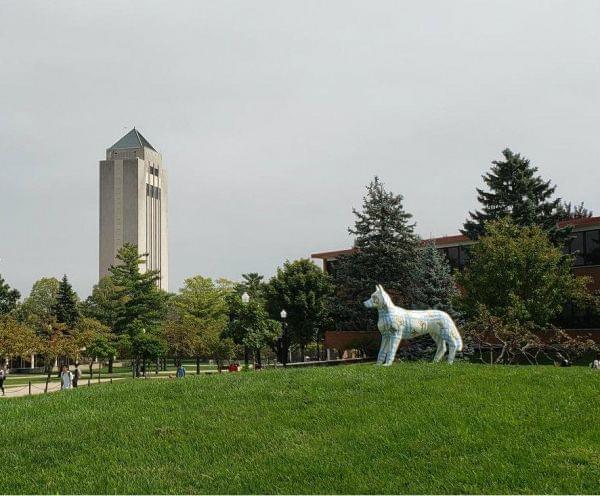Enrollment Exodus: Equity And The Effort To Retain Illinois Students

Holmes Student Center at Northern Illinois University. WNIJ
What happens when universities see enrollment plunge year after year? For many Illinois schools, they focus on how to hold on to the students already walking their halls. Students often leave between their first and second year.
That was the case for Chloe Watson. She was sitting in her dorm near the end of her first year at Northern Illinois University when it hit her. She had to find roommates for the next year, but couldn’t think of anyone she could live with.

This story is part of the weeklong Enrollment Exodus series, produced by public radio stations across the state, about challenges facing higher education in Illinois.
She never really found her place at the school and, truthfully, NIU wasn’t her first choice to begin with.
“I do think it's a good school, and I have friends that still go there, and they love it — I just don't think it was a good fit for me," said Watson.
Now she goes to the University of Illinois-Chicago. Many Illinois students leave the state to go to college, more than almost anywhere else in the United States.
But schools like NIU are not as worried about losing students to other states or other schools in Illinois.
Because of those riches of the volume of students coming through the door, I think we were less focused on retention.”Lisa Castillo-Richmond, Partnership for College Completion
Lisa Castillo-Richmond is the managing director of the Partnership for College Completion.
“There used to be this sort of increasing fountain of enrollment, there was always more students coming through the pipeline," she said. "And because of those riches of the volume of students coming through the door, I think we were less focused on retention.”
They’re a nonprofit that works with colleges in northern Illinois to help them increase retention rates and close equity gaps.
“When they take a look at their data, the biggest competitor that they have, in many cases of students that are admitted to their institution and choose not to attend, is nowhere," said Castillo-Richmond.
In 2017, 72% of NIU freshmen came back the next year. That’s around the state average.
RETAINING STUDENTS OF COLOR
Castillo-Richmond says gaps in equity emerge when you break the numbers down by ethnicity.
“Our state is one of the worst offenders in terms of the size of the degree completion gap between our African American students and our white students," she said.
The disparity is more pronounced at other schools in the state. Western Illinois University has a lower retention rate. White students return close to 80% of the time, while half of African American students don’t come back for their second year.
There are some Illinois universities with sky-high retention rates. For example, the University of Illinois at Urbana-Champaign is over 90%. According to the Partnership for College Completion, that could be linked in part to funding and resources.

SIU's student resources include a UNIV-101 course and online support to encourage students to speak up if they need help.
“A lot of times the institutions that are least well-resourced in this state, are the ones that are serving representative populations of students by race, ethnicity, by the income of their family," said Castillo-Richmond.
NIU prides itself on being accessible to underserved populations. A majority of students are first-generation. More than 40% are students of color. But with retention, universities can’t settle for access.
“Access without opportunity is problematic, right?” said Renique Kersh, associate vice provost for student engagement and success.
It’s part of her job to find the institutional stumbling blocks causing students to leave. A lot of times, that is in the first year. It can be struggling with coursework, trying to figure out financial aid or any number of issues.
At Southern Illinois University-Carbondale, they sort through the same things. Racial gaps remain, but retention rates are slowly on the rise. African American student retention is up to 59% from their low point of 45% several years ago.
“That's the highest it's been since, it looks like, about 2010," said Jennifer DeHaemers, the school’s associate chancellor for enrollment management.
Many people point to their mandatory one-semester UNIV-101 class as a primary reason for their retention increases.

"Virtual Victor" chat bot as seen on niu.edu/admissions.
At NIU, similar programs are in place. Its University 101 course is optional now, but Renique Kersh says they’re exploring making it required.
“If the majority of our students are first-gen, then it requires that we really look at how we can provide information about financial literacy and knowledge around navigating campus and navigating college beyond orientation," said Vernese Edghill-Walden. She's the chief diversity officer at NIU.
“Many times when we look at access, we talk about what the students bring to us, or what they don't bring to us and how we have been trying to reframe this conversation has really been around, what do we do as an institution that either supports or prohibits any students from being successful?” she said.
For both NIU and SIU that has meant changing how students are advised.
“In some cases, our advisor to student ratio was just too high,” said Kersh. She says whittling the ratio down to one advisor for every 300 students lets them interact more and intervene if a student is struggling.
They’re also increasing peer-to-peer mentoring for students in the same departments.
As universities race to raise their retention, the face of their students is changing. “Non-traditional” students are the new traditional.
And to meet the needs of all of those different students, they have to get creative. Southern Illinois now uses predictive analytics to identify students who may be struggling. NIU has an AI chatbot on its website dishing out financial aid information.
Even with a state budget increase for higher education this year, advocates say it’s going to take a sustained effort on the part of each institution to make sure the students who come in, stay in — and when they do leave, it’s with a degree.
This story is part of the weeklong Enrollment Exodus series, produced by public radio stations across the state, about challenges facing higher education in Illinois.
Links
- Why Latinx Enrollment At IL Community Colleges Holds Steady, But Gaps In Degree Attainment Persist
- Enrollment Exodus: How Private Colleges and Universities Are Meeting Enrollment Challenges
- Enrollment Exodus: Why So Many Chinese Students Choose That ‘Cornfield’ School In Illinois
- Enrollment Exodus: Public Universities Do More Than Educate Students
